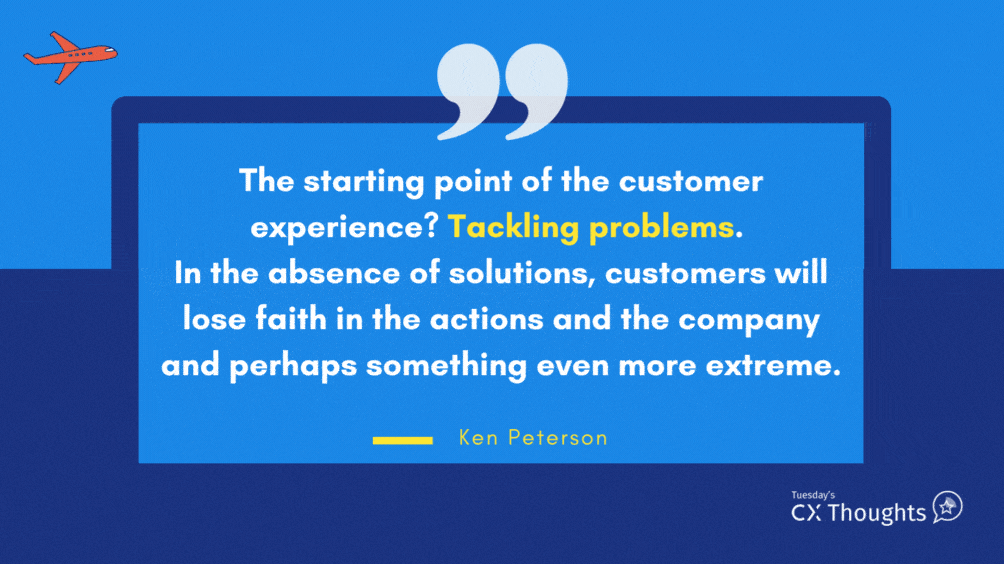 Reading Time: 4 minutes read
Reading Time: 4 minutes readLike most customer experience researchers, I’m always watching trends – both in the innovation and technology associated with customer experience and the stories about how businesses respond to customer breakdowns at scale.
Recently, I wrote about a problem of delayed luggage from my personal experience. It was a problem that was just starting to snowball as a part of the summer holiday season as has been written about extensively at this point.
While my experience was not part of the larger issue as it was an isolated incident, the comparable part has been the response to these incidents.
In reading most of these stories, the common theme has been airlines blaming airports, airports blaming airlines and both of them blaming a lack of employees due to ‘current circumstances’.
In other words, no one wants the finger pointed at themselves and the proposed solution is for the customer to take on the problem by not checking luggage.
Missing and at-large: Customer Experience
Having spent quite a bit of time in operational logistics before becoming a customer experience strategist and further getting to work with some of the most prominent travel, shipping and logistics companies with a focus on customer service and experience, I recognize the challenges of seemingly simple things like getting one item – such as a suitcase – from one destination to another.
At scale, it requires many steps, almost like a customer journey, each item shipped has a unique journey – origin, destination and stopovers along with things like special handling. Oftentimes a lost bag is a unique circumstance that often includes “human error” in one of the interactions.
LEARN ABOUT: Customer Journey Mapping Tools
In our customer feedback loop, this would result in a CX ticket that is handled individually with customer interaction. When it happens at scale, it is undoubtedly a system issue, better handled using tools like our QuestionPro Outer loop tool.
Ultimately, this problem had to be handled at scale – not as a one-off problem. Not a bottom-up approach but a top-down decision.
When I saw this article over the weekend about how one airline was handling it, it made me happy as a CX and Operations Researcher. It was simple, they took responsibility for the problem and searched for solutions.
In this case, it was a plane without passengers carrying luggage to a central point in the US so it could be redistributed across to customers that had to find alternative ways to get home due to mass cancellations.
It wasn’t seen as “how can we do this and make a profit?” or “can we blame someone?”. Instead, as stated by Delta themselves, it was a “creative solution” – sometimes the best thing for the customers – who will certainly appreciate the effort at the very least.
Connecting Flight: Customer, then Experience
Too often the focus of a customer experience program is on getting the “known” customer experience software platform to measure the Voice-of-the-Customer.
Then, many efforts go into sentiment and financial linkage analysis. When I hear a customer experience lead or project manager utter the words “is it statistically significant?”, I already know that the focus of a program has been lost.
It means that instead of trying to understand ways to improve the customer experience touchpoints, the company is instead trying to question something like the CX Enterprise Software. Instead of providing details to the customer journey map, the company is spending more time reviewing the customer journey template for perceived flaws.
The business challenge
Suppose you look at many of the organizations that are struggling right now with customer experience or employee experience. These same companies that do these things mentioned previously are the same ones now saying the customer cannot be serviced due to labor, inflation or supply chain.
They are the same ones posting notes on the door and closing service lobbies and with empty shelves. If they were conducting any sort of social media analysis, instead of finding solutions for customers they are also blaming many of the same things or the customer for their “misperceptions”.
Searching for the creative solution
One of the reasons for building our QuestionPro exclusive NPS+ is so companies can stop watching the score and have an immediate view of the problem as the customer perceives it.
Instead of questioning analytical processes and taking time to get good sample sizes, our root cause analytics with the NPS+ data provides an immediate building block to tackle problems.
That should be the starting point of the customer experience, tackling problems. It can be finding alternative products for your customers when the supply of critical items is insufficient, and sometimes it might be referring them to a competitor that can support them during this challenging phase. It might even be rolling up your sleeves as an executive and staffing a local branch.
Those creative solutions are what customers will expect. Without those solutions, they will lose faith in the actions and the company and perhaps something even more extreme. In some cases, it might be more expensive than a plane without passengers, but filled with luggage.
QuestionPro offers a robust online platform to help you manage customer experience and close the loop. Schedule a live demo with our CX professionals and learn how our CX software can help you increase brand loyalty and keep customers coming back.





















